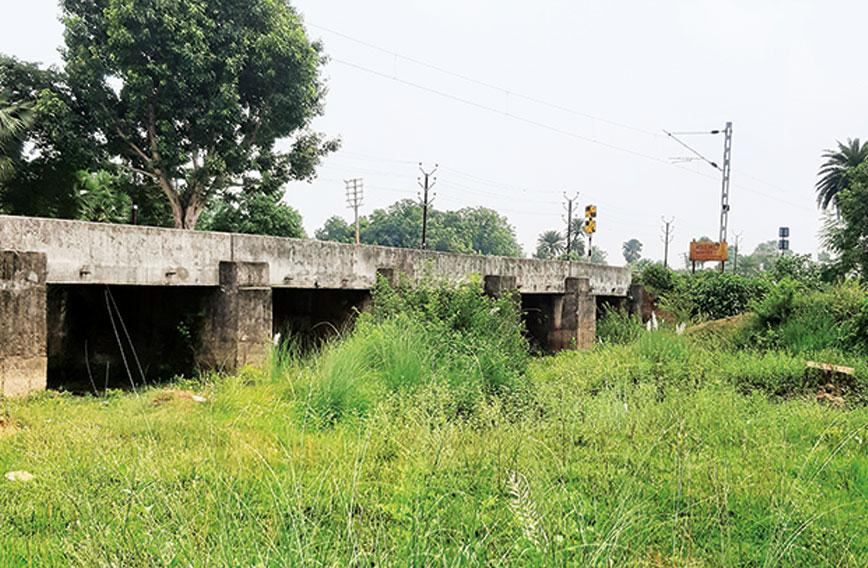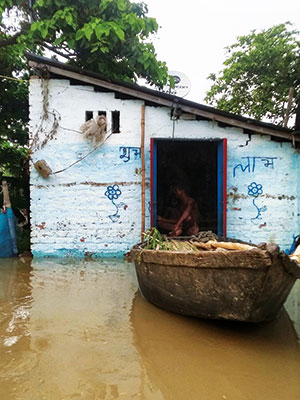
Here is a bridge over a river that is missing
Bridges, rail lines where small rivers once flowed
Ruchi Shree, Bhagalpur
IN recent years the incidence of floods in states like Bihar and Uttar Pradesh has gone up exponentially. My experience of living in Bhagalpur district of Bihar for three years gave me first-hand experience of floods. I was told that Bhagalpur faces floods every alternate year, but I witnessed flooding almost every year. Last year, Bhagalpur was flooded twice in the span of just three months.
In 2020, while teaching a paper on environment education to my political science students, I floated the idea of a project titled “Know Your River”. I asked them to gather information on small rivers near their villages or native places. We started documenting Bihar’s disappearing rivers through a three-step process. The first step is to gather information from all available secondary sources. Then, we go to the river to observe and document its current state. The last step is to collect the narratives of people living close to the banks of the river.
The importance of small rivers cannot be overstated. Rivers reflect the health of society. Small rivers or tributaries play a significant role in a river’s network and ecosystem. It is pertinent to note that ‘rejuvenation’, ‘restoration’, ‘riverfront development’ and ‘inter-linking of rivers’ is changing rivers in India on a massive scale.
A recent report cited by the Central Pollution Control Board (CPCB) suggests that 18 rivers of Bihar are immensely polluted, just like rivers across the country. The report, titled “Polluted River Stretches for Restoration of Water Quality 2022”, by the National Water Quality Management Network is worrisome. The silver lining is that some steps are being taken to restore and revive dying rivers in five states.
In the course of my research, I came across two small rivers, namely, the Andhari in Nathnagar block and the Nada in Jagdishpur block of Bhagalpur district which have had no water for the past decade.
I visited numerous villages such as Daradi, Kajraili, Karharia, Sanhaoula and Gonudham in these two blocks between April and September 2022, to trace the remains of the two dead rivers through the canals and bridges in their names.
Massive plantation had been done by the forest department on the dried riverbed of the Andhari over the years as part of the Bihar government’s Jal, Jeevan, Hariyali Mission. The plants are growing, and the area is likely to have trees in years to come. But this will not bring the river back.
Since there is a bridge and railway track named after the Andhari and Nara, these rivers remain etched in the memory of local people. They explained to us the impacts of dying rivers. These included massive migration from villages and the changing pattern of agriculture with excessive dependence on groundwater. Under the Har Ghar Nal ka Jal scheme of the government of Bihar, some residents of Daradi village have taps but water supply is irregular.
A resident of Daradi village on the bank of the dry Andhari told us: “Ever since the new bridge came up on the river, there is no water in it. Our villages have become like towns since there is no drinking water. The water in our taps comes once in two or three days and we have to depend on handpumps.” The women said that sometimes they are unable to bathe for two or three days due to lack of water.
 For the past three years I have been collecting facts and narratives around the Champa river, a tributary of the Ganga in Bhagalpur district, to assess the range of problems facing small rivers. An ethnographic study of two villages, Deldarpur and Biharipur in Nathnagar block of Bhagalpur district on the bank of the Champa, suggests that river-dependent communities, especially fisherfolk and boatmen, are forced to switch to other occupations such as wage labour or vegetable selling. Due to increased pollution and less water in the river and the dwindling number of fish, fishermen are forced to migrate to cities like Surat and Mumbai to earn a livelihood.
For the past three years I have been collecting facts and narratives around the Champa river, a tributary of the Ganga in Bhagalpur district, to assess the range of problems facing small rivers. An ethnographic study of two villages, Deldarpur and Biharipur in Nathnagar block of Bhagalpur district on the bank of the Champa, suggests that river-dependent communities, especially fisherfolk and boatmen, are forced to switch to other occupations such as wage labour or vegetable selling. Due to increased pollution and less water in the river and the dwindling number of fish, fishermen are forced to migrate to cities like Surat and Mumbai to earn a livelihood.
PEOPLE REMEMBER
The residents of Biharipur told us that the Champa used to have water throughout the year until a decade ago. It was their main source of irrigation. The river water was used for everyday purposes from bathing cattle to washing clothes. Now the river has water for only four to six months. So, we may say that the Champa was a perennial river which slowly turned into a seasonal one.
It was striking to note that the villagers call the Champa river Chhoti Ganga (small Ganga) and say it is their lifeline. They say, “Shaher ke log nadi ko ganda kar dete hain, hamara toh jeevan hi nadi se juda hai” (City dwellers make the river dirty. But our lives are intertwined with the river). They also say that the “Champa is a nullah (drain) for city dwellers but for us it is a river”.
Deldarpur is a diara (land created in the middle of the Ganga due to deposition of sand over decades) village located between the Champa and the Ganga. The village, of around 2,000 residents, is connected to the mainland or to Bhagalpur city through a small manmade bamboo bridge. During the monsoon, the only way to reach the village is by boat. The village remains under water for almost three months every year.
 Deldarpur has no primary health centre (PHC) and only 30 percent of households have access to toilets. The groundwater is contaminated with a high amount of iron and arsenic. Like Biharipur, Deldarpur too faces seasonal migration of its residents for better work opportunities. Both villages contend with floods every year and residents are forced to shift to safer areas nearby for a few weeks to a few months, depending on the intensity of the flood. This pattern of floods and agriculture is undergoing slow and steady transformation.
Deldarpur has no primary health centre (PHC) and only 30 percent of households have access to toilets. The groundwater is contaminated with a high amount of iron and arsenic. Like Biharipur, Deldarpur too faces seasonal migration of its residents for better work opportunities. Both villages contend with floods every year and residents are forced to shift to safer areas nearby for a few weeks to a few months, depending on the intensity of the flood. This pattern of floods and agriculture is undergoing slow and steady transformation.
During my research on small rivers with special reference to the Champa river in Bhagalpur district, I came across rampant sand mining in adjacent areas, fast depleting groundwater, dumping of garbage on the riverbed, and massive construction close to rivers, to name a few factors. Consequently, the flora and fauna of the river’s ecosystem are adversely affected. The Champa is likely to die a slow death in coming years. The Bhagalpur region used to be called Angchampa at one time. Now, the Champa Nalla is just a deserted part of the city.
REVIVAL AND RESTORATION
However, an effort is underway to revive small rivers. Over the past four years, 75 small rivers, mostly in UP, have been identified for rejuvenation under the National Rural Employment Guarantee Scheme (NREGS). The National Mission for Clean Ganga (NMCG) has proposed drafting urban river management plans (URMPs) and that river-sensitive master planning be made mandatory for river cities. In December 2022, a meeting of the National Ganga Council (NGC), the apex authority of NMCG, was held in Kolkata. The NGC includes the prime minister and the chief ministers of five states: Uttar Pradesh, Uttarakhand, Bihar, Jharkhand and West Bengal.
The River City Alliance (RCA) project of the NMCG was launched in February 2022. Thirty cities along the banks of the Ganga have been selected to plan sustainable management of urban rivers. They include four cities in Bihar, namely, Patna, Begusarai, Munger and Bhagalpur. In Bihar, in the past few years, parts of Lakhandei river in Sitamarhi district, the Dhanauti river in East Champaran district, and the Falgu river in Gaya district have been rejuvenated by the collaborative efforts of the state and civil society.
Lakhandei, a tributary of the Bagmati, originates in Nepal, enters Bihar in Sitamarhi and pours into the Bagmati at Katra in Muzaffarpur. The estimated length of the river is nearly 18 km. Callous waste disposal and encroachment on river land has caused the river to deteriorate over the years. Lakhandei has now been revived after 40 years. This rejuvenation programme was undertaken by the Bihar government under the Ministry of Jal Shakti’s Jal Shakti Campaign in 2019. The revival plan, yet to be completed, is likely to boost agriculture on nearly 2,540 acres spread across four administrative blocks.
East Champaran won the Best District award under the Rashtriya Jal Puraskar in 2020 for rejuvenating an 80-km stretch of the Dhanaulti river, a tributary of the Burhi Gandak. About Rs 69 lakh was spent on desilting the riverbed and close to Rs 2.5 crore on plantation on both banks, utilizing NREGS funds.
A riverfront development project was also completed which included beautifying the banks to enable residents to spend time there. Although the efforts of the district administration have been lauded, local residents are not happy. They were formerly engaged in fishing but lost their livelihood due to the deteriorating state of the river and consequently migrated to other states in search of employment.
The findings of my ongoing research suggest that eco-centric planning of cities is the need of the hour. The state and society must come together to involve local communities in river rejuvenation. We need to stop dumping garbage in rivers and encroaching on riverbeds. To clean the Ganga and other major rivers, we need to pay equal attention to the numerous problems faced by their several tributaries, the small rivers across the country.
Dr Ruchi Shree is assistant professor at the PG Department of political science at TMBU, Bhagalpur, Bihar, and a research associate with the School of Law, School of Oriental and African Studies, University of London.
Comments
Currently there are no Comments. Be first to write a comment!




